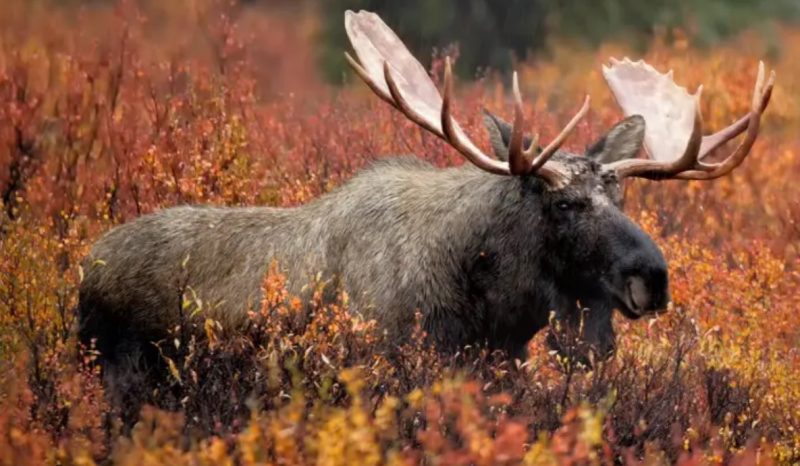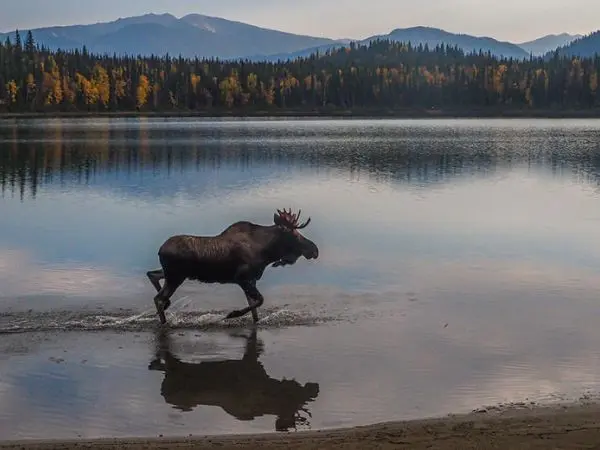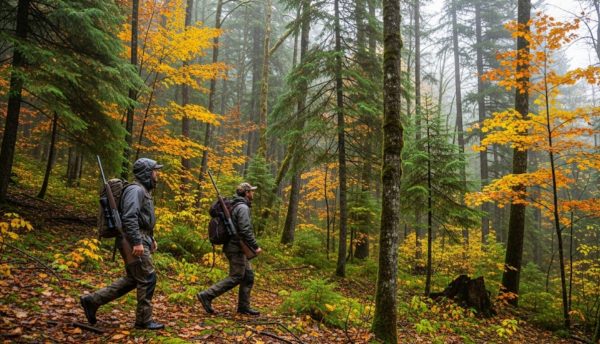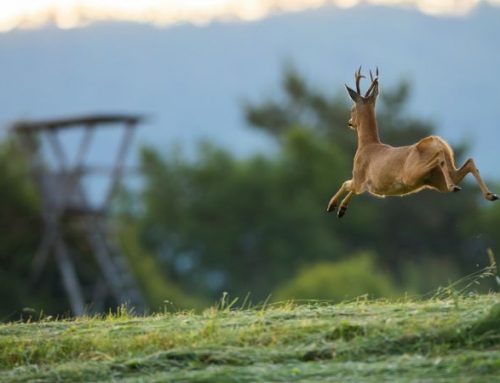Hunting in Canada: Discover a Landscape of Natural Wonders, Picturesque Cities, and Unspoiled Treasures—From Rocky Mountains to Endless Rivers, Amidst the Spectacle of the Northern Lights.
In the far west of Canada lies one of the most spectacular and beautiful regions of the country: British Columbia.

A true paradise rich in natural parks, mountains, lakes, and rivers, British Columbia hosts a large number of moose and caribou, making it an ideal place for hunting big game trophies.
British Columbia is now the quintessential destination for big game hunting and in the past was home to Paleo-American nomadic hunter-gatherer populations who arrived through the Bering Strait, known as the “Gateway to America.”
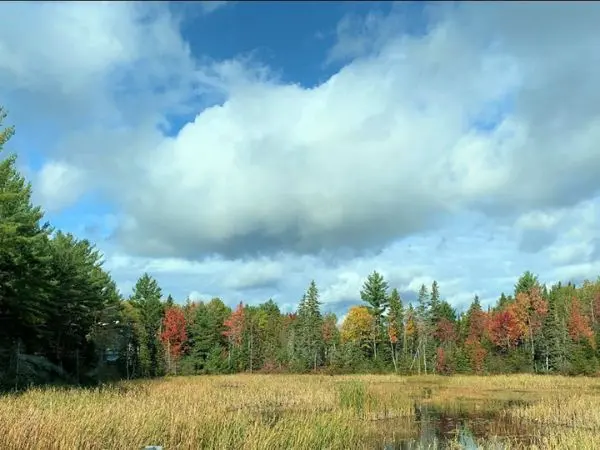
Canada, with its vast territorial expanse, is a true paradise for hunters, offering millions of square kilometers of hunting opportunities in wild and natural landscapes, permeated by silence interrupted only by the murmur of rivers.
To experience the thrills and excitement that only true and extreme hunting can offer, it’s worth crossing the Atlantic Ocean to reach these splendid territories.
Moose Hunting
From mid-September, the foliage of Canadian forests begins to sparkle in shades of purple, crimson, gold, and copper.
Indian summer is on its way. The splendor of this riot of colors in the vast forests is incomparable.
The colors of the Indian summer frame the Canadian autumn days and thus your hunting days.
It is during this time of year that the large moose experience the mating season, with males restlessly moving between lakes and forests in search of females or a rival to challenge.

Hunters, assisted by a good guide, attract them with a handmade call made from birch bark that faithfully reproduces the “love call”.
The male moose won’t take long to respond to the call.
Approaching must be slow and gradual: these animals have excellent hearing, and when they hear suspicious noises, their cautious and wary nature makes them intensely look in that direction.
Embracing the Wilderness: A Moose Hunt in British Columbia
The wilderness of British Columbia stretches out before us, a vast expanse of untamed beauty, where the air is thick with the scent of pine and the symphony of the wild is our only accompaniment. Here, in this majestic land, we embark on a hunt that is as much about connecting with nature as it is about the pursuit of one of its most magnificent inhabitants – the mighty moose.
Dawn’s Gentle Awakening
As dawn’s first light gently kisses the peaks of the Canadian Rockies, we find ourselves deep in the heart of British Columbia. The sky, a canvas of pastel hues, reflects off the mirror-like surface of a secluded lake, creating an ethereal backdrop for our journey. The stillness of the morning is broken only by the soft rustling of leaves and the distant call of a loon.
Our guide, an old hand with a weathered face and eyes that seem to hold the secrets of the forest, leads us into the depths of the wilderness. His knowledge of the land is profound, and his respect for its inhabitants, palpable. As we move through the dense underbrush, the anticipation builds, each step bringing us closer to the domain of the moose.
The Majesty of the Moose
The moose, the largest member of the deer family, is a creature of incredible stature and grace. Bulls can stand over six feet at the shoulder, their massive antlers spanning up to six feet wide, a testament to their dominance and power. Despite their size, moose are elusive and solitary, often found in the remote and rugged areas of the forest.
Their appearance is almost otherworldly – a blend of strength and elegance. With long legs built for wading through marshes and a distinctive dewlap, or “bell,” hanging from their throat, moose seem to embody the spirit of the wilderness itself. Their dark, soulful eyes and majestic antlers, rising like a crown, command both awe and respect.
The Silent Stalk
As the sun ascends, casting golden rays through the canopy, we come across signs of our quarry – fresh tracks and the unmistakable markings of a moose’s passage. The air is electric with possibility. We move with the stealth of shadows, every sense attuned to the world around us. The forest, with its towering trees and dense undergrowth, becomes a labyrinth of mystery and wonder.
Suddenly, we spot him – a bull moose, grazing in a meadow bathed in sunlight. He is magnificent, his antlers a regal crown, his every movement a dance of power and grace. The moment is surreal, time seemingly suspended as we watch this king of the forest in his natural habitat.
Our guide signals for us to ready our rifles, the moment of truth at hand. Heart pounding, I take a deep breath, steadying myself. The shot must be true, for this is no mere hunt, but a sacred rite, a tribute to the majesty of the moose and the wild.
The Moment of Reverence
The shot rings out, echoing through the trees, and the moose falls. We approach with reverence, grateful for the life that has been given. There is a deep sense of connection, a recognition of the circle of life that binds us all. We honor the moose, thanking the land and the spirit of the wild for this profound experience.
As we prepare the moose for transport, the sun begins its descent, casting long shadows across the landscape. The forest, once again, embraces us in its serene silence, and we feel a profound sense of peace and fulfillment.
Evening’s Embrace
Back at camp, under a sky awash with stars, we gather around the fire, sharing stories and reflecting on the day’s journey. The crackling flames and the scent of wood smoke create a comforting cocoon, a stark contrast to the wild expanse that surrounds us. We feast on a hearty meal, the fruits of our labor, savoring the rich flavors and the camaraderie of fellow hunters.
The wilderness of British Columbia, with its rugged beauty and untamed spirit, has gifted us an experience that transcends the act of hunting. It is a journey of the soul, a communion with nature, and a celebration of the majestic moose, a symbol of the wild’s enduring mystery and power.
As I lay in my tent, the sounds of the forest lulling me to sleep, I am filled with a deep gratitude. The hunt has been more than an adventure; it has been a pilgrimage into the heart of nature, a reminder of our place within this vast and beautiful world.
Caribou Hunting: A Journey Through the Wilds of British Columbia
Amidst the serene rivers, shimmering lakes, and boundless forests of British Columbia, a hunt for the fascinating mountain caribou unfolds. This majestic creature, a symbol of the wild, beckons hunters into the heart of Canada’s unspoiled territories, offering an adventure as enchanting as it is challenging.
The Majestic Caribou
The caribou, also known as reindeer in some parts of the world, is a marvel of nature. Their antlers, sprawling and intricate, are a testament to their grandeur, while their coats, varying from the pristine white of smaller breeds to the darker hues of larger ones, add to their mystique. These magnificent animals move in herds across the open plains, their collective presence a spectacle against the rugged Canadian landscape.
During the mating season, the air is filled with the echoes of clashing antlers as bulls vie for dominance and the right to mate. These displays of strength and stamina are not only a testament to the caribou’s power but also a mesmerizing dance of nature that captivates all who witness it.
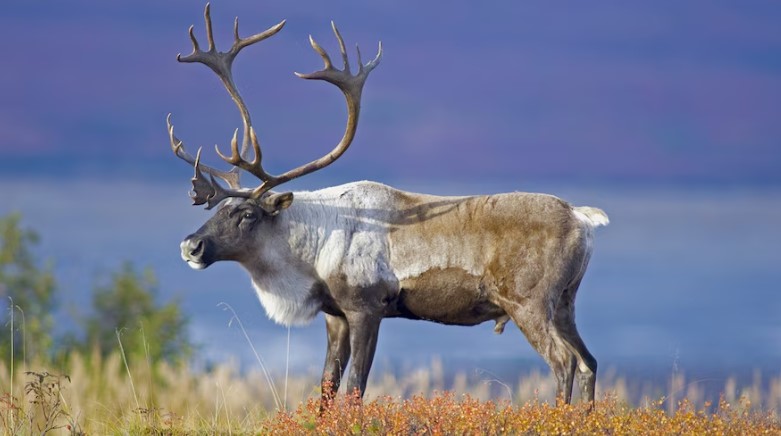
The Art of the Hunt
Hunting caribou is an endeavor that requires not only skill but also deep respect for the animal and its habitat. Caribou possess keen eyesight, able to detect the slightest movement from afar, challenging even the most seasoned hunters. Thus, a successful hunt demands mastery of approach and camouflage.
Techniques of the Hunt
- Stalking: This technique involves moving slowly and silently, using the natural cover of the terrain to get close to the herd. Patience is key, as any sudden movement or noise can startle the caribou, sending them running.
- Spot and Stalk: From a vantage point, hunters use binoculars or spotting scopes to locate a herd from a distance. Once a suitable target is identified, the hunter begins a careful stalk, closing the distance with meticulous precision.
- Camouflage and Concealment: Blending into the environment is crucial. Hunters wear gear that mimics the colors and patterns of the terrain, reducing the chances of being spotted.
- Wind Direction: Caribou have a strong sense of smell. Approaching from downwind ensures that the hunter’s scent is not carried towards the herd, which could alert them to the presence of danger.
A Romantic Wilderness
The hunt is not merely a pursuit of the caribou; it is an immersion into the wilderness, a step back into a time when the rhythm of life was dictated by the land and the seasons. The journey often involves traversing the rugged terrain on horseback, forging a bond with the animal companions that carry us through the wilderness. Each day ends in rustic cabin accommodations, where the warmth of a crackling fire and the simplicity of the surroundings bring a sense of peace and fulfillment.
The landscape of British Columbia, with its majestic mountains and vast, open plains, provides a backdrop that is as awe-inspiring as the hunt itself. The silence of the early morning, the whisper of the wind through the trees, and the distant call of a loon create a symphony that speaks to the soul.
The Essence of the Hunt
The hunt for caribou is more than a quest for a trophy; it is a journey into the essence of nature. It is about understanding the rhythms of the wild, respecting the creatures that inhabit it, and embracing the timeless traditions of hunting. As we navigate this breathtaking landscape, we are reminded of the delicate balance that sustains life and the profound connection we share with the natural world.
In the end, the true prize is not the antlers we bring back, but the memories we forge, the lessons we learn, and the deep appreciation we gain for the majestic caribou and the wild places they call home. As we sit by the fire, recounting the day’s adventures, we are filled with a sense of gratitude for the opportunity to be part of something so timeless and beautiful.
The caribou hunt in British Columbia is a journey into the heart of the wild, a dance with nature that leaves an indelible mark on the soul. It is a reminder that, in the grand tapestry of life, we are all connected by the threads of nature, adventure, and the enduring spirit of the hunt.
My caribou hunt in British Columbia (Janez Curl – Slovenja)
“It’s hard to explain what you feel when, after days spent in the wild silence of British Columbia, you finally see it. The caribou. Still. Silent. A majestic figure outlined against the dark pine trees swept by the wind. But let me start from the beginning.
I left Slovenja with a heart full of expectations and an old hunger: the desire to lose myself in a pristine land, where man is just a guest and nature writes the rules. Fifteen days of true adventure awaited me, riding through the Canadian mountains, near the Finlay River.
My PH was a man of few words but sharp eyes. He had explained it all calmly: “Janez, this is real hunting. We’ll need to walk, listen, wait. And trust your instincts.” That’s exactly what I wanted.
The first few days were intense. Waking up before dawn, setting up camp under breathtaking starry skies, binoculars always hanging from my neck. Caribou? Not a trace. Yet every passing hour brought me closer to something deeper than just the animal.
On the ninth day, while crossing a grassy hollow, the PH suddenly stopped. I watched him raise his binoculars slowly, then glance at me with a nod. There, about 300 meters away, a mature bull was moving gracefully. Antlers like birch branches. Regal steps.
I crouched down. Slowed my breath. My hand on the rifle’s stock. The caribou stopped, as if sensing the tension. I pulled the trigger only when I felt the moment was right. The shot rang out. A few seconds later, he was down.
I approached with respect. What I felt wasn’t joy or triumph, it was gratitude. Gratitude for the majestic animal. For the land that had offered it to me. And for myself, for having lived a dream I had carried for years.
That night, by the fire, the PH told me: “You hunted like a man who understands. Not everyone does, around here.” And in that moment I knew that those silences, those waits, had taught me more than I could have imagined.
FAQ – Moose and Caribou Hunting in Canada with Montefeltro
1. Why choose Canada for moose and caribou hunting? What makes it so unique?
Canada offers a hunting experience like nowhere else on Earth. In the heart of British Columbia and other wild provinces, vast untouched lands stretch beyond the horizon, home to some of the largest populations of moose and migratory caribou. The combination of majestic wilderness, low hunting pressure, and expertly managed reserves makes Canada one of the last true frontiers for big game hunting. It’s not just a destination — it’s a return to primal nature.
2. What’s the best time of year to hunt moose and caribou in Canada?
The prime season for both species generally runs from mid-September to late October, depending on the region. Moose enter their rut during this period, making them more responsive to calls and easier to locate. Caribou migrations also peak in these weeks, giving hunters the chance to intercept herds moving through scenic highland passes and valleys.
3. Where in Canada do Montefeltro hunts take place?
Montefeltro organizes its Canadian big game hunts primarily in British Columbia, a province celebrated for its rich biodiversity and dramatic terrain. Here, our local partners operate in territories that include dense forests, alpine meadows, river basins, and mountain slopes — habitats ideal for both moose and caribou. Some combo hunts may also take place in selected parts of Alberta or Yukon, depending on quotas and client preferences.
4. Can I hunt both moose and caribou in a single trip?
Absolutely. Many of our Canadian adventures are designed as combo hunts, allowing you to pursue both species in a single expedition. This is possible in carefully selected regions where the habitats of moose and caribou overlap. It’s a dream opportunity for hunters seeking a truly rewarding and multi-faceted big game experience.
5. What kind of hunting methods are used?
Most hunts are conducted using the spot-and-stalk method, which combines glassing vast areas with physical stalking through the terrain. During the moose rut, guides often use vocal calls to simulate cow moose or rival bulls, drawing the animals into range. For caribou, we often intercept migrating groups from strategic vantage points or follow signs across open tundra and ridges.
6. What type of gear and weapons do I need for moose and caribou hunting?
A reliable high-caliber rifle is essential. We recommend calibers like .300 Win Mag, .338 or similar — flat-shooting, hard-hitting cartridges ideal for long-distance accuracy and big-bodied animals. Binoculars, rangefinders, layered clothing for unpredictable weather, waterproof boots, and a good backpack are also crucial. Our team provides a complete checklist and support during preparation.
7. How are the hunts organized logistically?
Montefeltro handles every detail from start to finish. Clients fly into a designated hub (often Vancouver or Prince George), from which they’re transferred to base camps via vehicle or bush plane. Depending on the program, lodging may be in rustic log cabins, tented camps, or lodge-style accommodations. Every hunter is accompanied by a local, licensed guide who knows the terrain and animal habits intimately.
8. Are these hunts physically demanding?
While we tailor the hunt to match the physical condition of each hunter, it’s important to note that Canadian terrain can be rugged and remote. Some hiking or walking through uneven ground is often required. However, we also offer hunts from fixed blinds, boats, or horseback in certain locations for those who prefer a less strenuous approach.
9. How sustainable and regulated is hunting in Canada?
Canada has some of the most strictly regulated and scientifically managed hunting systems in the world. Every hunt is conducted under license and quota, ensuring that moose and caribou populations remain healthy for future generations. Conservation is a top priority, and we work only with outfitters who share our values of ethical, respectful, and sustainable hunting.
10. What can I expect from a Montefeltro hunting experience in Canada?
Expect professionalism, comfort, passion, and unforgettable memories. From the moment you arrive, you’re guided by experts who live and breathe the wilderness. You’ll be immersed in Canada’s breathtaking landscapes, share stories around a fire, and return home with more than a trophy — you’ll carry the soul of the hunt with you. Our support is full-service, with custom itineraries, gear advice, documentation assistance, and attentive local hospitality.
11. Do I need a specific hunting license or tags?
Yes. Montefeltro arranges all necessary licenses and species-specific tags in advance, based on provincial regulations and your desired itinerary. We’ll guide you through the process to ensure compliance with all legal requirements.
12. Can I bring my harvested trophy back to Europe or the U.S.?
Yes, though exporting moose or caribou trophies involves permits and regulated procedures. Our team assists in preparing trophies for transport and can recommend trusted taxidermists and shipping services. Please note that waiting times for delivery may vary depending on country and customs laws.
13. Is it safe to travel to and hunt in Canada’s wilderness?
Canada is an extremely safe destination. Our hunts take place in controlled, guided settings with satellite communication, emergency plans, and experienced staff. Wildlife encounters are part of the thrill — but always handled with care and respect.
14. Can I travel with companions or non-hunters?
Of course. Many of our clients bring spouses or friends who want to enjoy photography, nature, or simply the escape into Canada’s great outdoors. Some camps even offer side activities like fishing or canoeing.
15. How long do the hunts usually last?
Most of our moose and caribou hunting trips in Canada last 7 to 10 days, including travel and acclimatization. This allows for a proper immersion into the environment and increases the chances of success.

